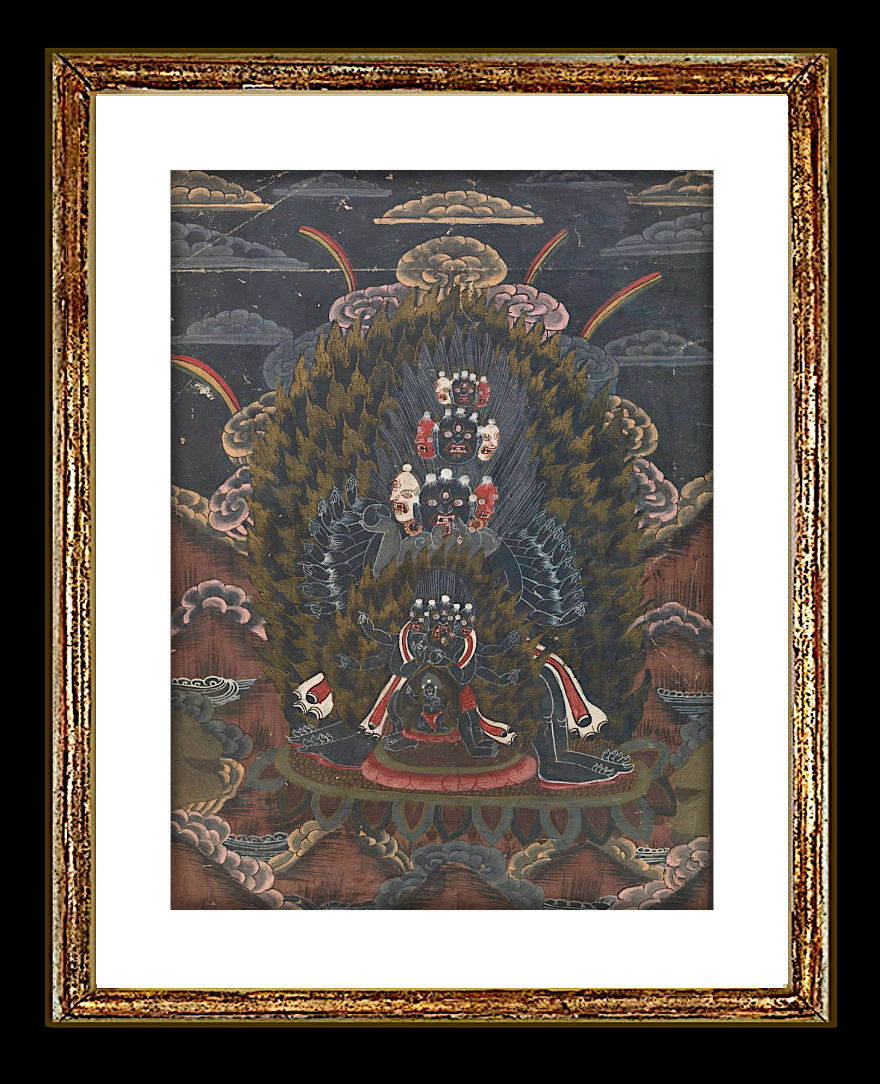

Title: 19th Century Antique Tibetan Tribal Hand-Painting Thangka
Shipping: $29.00
Artist: N/A
Period: 19th Century
History: Ancient Art
Origin: Central Asia > Nepal
Condition: N/A
Item Date: N/A
Item ID: 461
A 19th-century Tibetan Hand-Painted Thangka on Silk-Linen Blend. Consisting of hand-painted polychrome Colors. Avalokiteshvara Buddhist thanks, with multi heads and multi-armed Buddha with different gods around on polychrome background, framed under glazing in a contemporary frame, 20 ½" x 16 ⅜". Provenance: old private collection, acquired in Kathmandu, Nepal, in mid-1970s-1980. Thangka is a traditional form of Tibetan Buddhist painting that is typically done on cotton or silk fabric and is often framed with silk brocade. These hand-painted thangkas depict various deities, figures, and symbols that are significant in Tibetan Buddhism. The 19th century was a time of great change in Tibet, as the region was increasingly influenced by outside forces such as the British and Chinese empires. This period also saw a revival of Tibetan Buddhism, which had suffered during the previous century due to conflicts with the Gelugpa sect, which dominated the Tibetan government. During this time, thangka painting underwent a transformation, as artists began to experiment with new techniques and styles. One of the most significant developments was the introduction of brighter and more vibrant colors, which were made possible by the use of new pigments that were imported from India and China. Another innovation was the incorporation of Western-style perspective and shading, which added depth and dimension to the figures depicted in the thangkas. This was particularly evident in the portrayal of landscape and architectural elements, which were often rendered with great attention to detail. Despite these changes, traditional thangka painting techniques and themes remained popular throughout the 19th century. Many of the most famous thangka paintings of this era were commissioned by monasteries and religious leaders, and depicted important deities and scenes from Buddhist scripture. One notable example is the Wheel of Life thangka, which is a symbolic representation of the Buddhist concept of samsara, or the cycle of birth, death, and rebirth. This thangka features a central image of a wheel that is divided into six realms of existence, each of which is inhabited by different types of beings. Overall, the 19th century was a time of great creativity and innovation in Tibetan thangka painting, as artists combined traditional techniques with new styles and influences to produce some of the most beautiful and intricate works of art in the Tibetan Buddhist tradition.
Tibetan Buddhist paintings, also known as thangkas, have a long and rich history that dates back over a thousand years. These paintings are typically created on cotton or silk fabric, and are often adorned with brocade or silk borders. Thangkas serve as visual aids for meditation and as objects of devotion in Tibetan Buddhism. The origins of thangka painting can be traced back to the 7th century CE, when Buddhism was first introduced to Tibet from India. The earliest thangkas were likely created by Indian artists, who taught their techniques to local Tibetans. These early thangkas depicted Buddhist deities and teachings, and were used to help spread Buddhism throughout Tibet. Over time, thangka painting developed into a distinct art form in its own right, with its own unique styles and techniques. Thangkas became more complex and intricate, with detailed depictions of deities, mandalas, and other symbolic images. One of the most important developments in the history of thangka painting was the establishment of the Karma Gardri tradition in the 15th century. This tradition, which is still practiced today, is known for its highly precise and detailed depictions of deities and other figures. Thangkas also played an important role in the development of Tibetan Buddhist monasticism. Monks would often spend many years studying and meditating on thangkas, using them as tools for spiritual development and enlightenment. In addition to their religious significance, thangkas are also highly valued as works of art. Many thangkas have been created by famous artists throughout history, and are considered to be masterpieces of Tibetan Buddhist art. Today, thangka painting remains an important aspect of Tibetan culture and religion. Thangkas are still created by artists using traditional techniques, and are widely used in meditation and worship. They are also highly valued by collectors and art enthusiasts around the world.